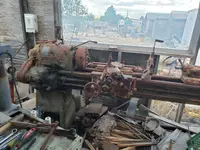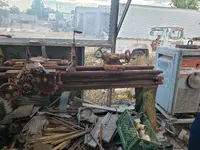There is a company back east that sells anodizing and plating chemical/systems you may want to check out. They have an electroless nickel solution that you can add PTFE or Boron Nitride to increasing corrosion resistance while actually bonding to the base metal. Plus, you can circulate the solution through the interior of the equipment, even heat exchangers and such. I don't know if I can insert links but let me know if you are interested. Epoxy wouldn't be a bad way to go either, I know Masterbond makes some highly resistant kits for lining pipes and vessels.
At my company, we deal with a variety of acids, superacids, solvents, bases in contact with mixers, pumps, distillation, et. al.. Of course, not all this occurs in a singular instance so we also have to select materials per application. Anyways, point being, a lot of things are rated a certain way but actually work fine for some time in most conditions. Corrosion in metals is always measured as a rate, whereas plastics it is either go or nogo. Most industries have to balance cost of materials with an acceptable rate; as opposed to using bulletproof materials. This is what most charts don't disclose and to minimize liability they will err towards extreme caution (hard to disagree with).
Chloride cracking is a known issue in austenitic ss but 316L can often make the difference over 304 due to higher nickel +Molybendum. Also, even a minor presence of oxygenation can significantly decrease the effect of said chlorides. Finally, temperature/pressure are really the dominant components of this particular triangle (shocker, huh)... Otherwise, one has to look to either 400 series (martensitic) alloys or exotics like Alloy20, Duplex, Hastelloy.
So, there's that... This is a very interesting topic for me and for the first 12 years of my adult life, I was a welder (primarily Stainless) with certs in PP and PV so I would be happy to lend an ear/hand/voice if you're itching to make some pro-grade process equipment.





